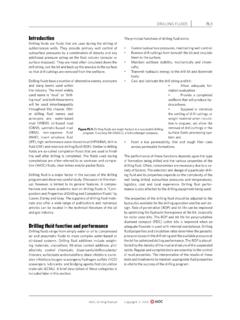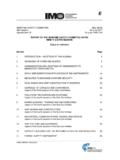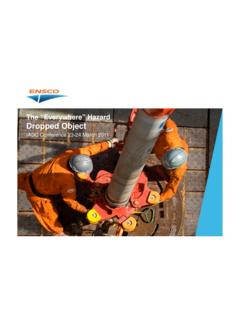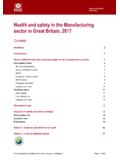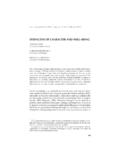Transcription of IADC INCIDENT STATISTICS PROGRAM
1 IADC INCIDENT STATISTICS PROGRAM 2014 IADC INCIDENT STATISTICS PROGRAM Revised 04 January 2014 2 Table of Contents Reporting Procedures 4 Company Identification 4 Reporting Forms 4 Reporting Incidents (injuries or illnesses) 4 Corrections & Changes 5 Reporting Regions 5 Reporting Deadlines 6 Work Hours 6 Agency Labor 6 Employees Living on Company Premises 6 Estimating Work Hours 6 Training Hours 6 Off-Duty Hours 6 Reporting Work Hours 6 Published Reports 7 Quarterly Summary Reports 7 Annual Report 7 INCIDENT Analysis 7 Identification of Participants 7 Rig Recognition Provisions 8 Eligibility Criteria 8 General Guidelines 8 Recordable Incidents (Injuries or Illnesses)
2 8 Lost Time Incidents 8 Certificates and Plaques 9 Definitions 9 Days Since Last LTI or Recordable INCIDENT 9 INCIDENT Categories 9 Fatality (FTL) 9 First Aid 9 Lost Time INCIDENT (LTI) 10 Medical Treatment Only 10 Prescription Medication 10 For Purposes of IADC ISP Reporting, Prescription Medication Means 10 Verification of Drugs (FDA Website) 11 Recordable INCIDENT (Injuries or Illnesses) 11 Significant INCIDENT 11 The following incidents would be recordable, but the type of Recordable INCIDENT will depend on the severity of the injury or illness 12 Restricted Work/Transfer Case (RWTC)
3 12 Illness 13 Lost Time INCIDENT Experience 13 Rate Calculations 13 Frequency Rate 13 Incidence Rate 13 Routine Functions 13 Work-Related 13 Work-Related Vehicle Incidents 14 2014 IADC INCIDENT STATISTICS PROGRAM Revised 04 January 2014 3 Harmonization of IADC vs OSHA vs OGP 14 2014 IADC INCIDENT STATISTICS PROGRAM Revised 04 January 2014 4 2014 IADC INCIDENT STATISTICS PROGRAM Official Rules and Guidelines Effective January 1, 2014 to December 31, 2014 INTRODUCTION: The purpose of this PROGRAM is to assist in the industry's efforts to improve safety on oil and gas well rigs by providing data on INCIDENT trends and rates.
4 The data contained in IADC's ISP PROGRAM is submitted voluntarily and is audited by IADC s Quality Assurance Department. Every effort has been made by IADC to assure the accuracy and reliability of the data contained in reports developed from the data submitted, however, IADC makes no representation, warranty or guarantee in connection with these reports and hereby expressly disclaims any liability or responsibility for loss or damage resulting from the use of this data. IADC is not attempting to fulfill any duties or obligations of employers to warn, properly train or equip their employees or others who may be affected by their activities, concerning any health, safety, or environmental risks or precautions.
5 Charts contained in reports may be reproduced or copied but the ISP data contained in the reports is not to be modified in any way. All drilling or well servicing companies involved in oil and gas well drilling are eligible to participate in the IADC INCIDENT STATISTICS PROGRAM . These IADC ISP Guidelines and the IADC ISP Question and Answer Book, although similar to certain governmental regulations, are industry accepted guidelines and should not be relied upon when determining the reporting and tracking of incidents that are required by (some or various) governmental agencies. Reporting Procedures Company Identification: To submit reports to the PROGRAM , each company must have an ID number for the current year assigned by IADC Headquarters.
6 When assigned a number, the contractor will receive a set of reporting forms to record employee man-hours and INCIDENT information on a monthly basis. Details on individual incidents are to be included on a separate Supplemental INCIDENT Report (SIR) form. Reporting Forms: a) Company Composite Form: This form is a summary of the reported incidents and man-hours for the time frame. b) Supplemental INCIDENT Report (SIR) form: One of these report forms must be completed for each INCIDENT reported on the Company Composite Form. c) Supplemental INCIDENT Composite Spreadsheet: This spreadsheet is not included in your package, but if you wish to use it in place of the Supplemental INCIDENT Form, contact the IADC office and a copy will be sent to you.
7 Do not submit both the Supplemental INCIDENT Form and the Supplemental INCIDENT Composite Spreadsheet. Reporting Incidents (injuries or illnesses): Participating companies should report all work-related recordable injury or illness cases that occur to participant employees (those assigned to rigs as well as shore based administrative and support personnel). Cases should be reported according to the most appropriate 2014 IADC INCIDENT STATISTICS PROGRAM Revised 04 January 2014 5 category: Fatality (FTL), Lost-Time INCIDENT (LTI), (days away from work case [DAFWC]), Restricted Work/Transfer Case (RWTC), or Medical Treatment Only (MTO). These incidents should be reported on the monthly report on a calendar month basis, from the first of the month to the end of the month.
8 First Aid cases are not considered to be recordable and should not be included in the participating company s reporting data. (See the Definitions section for more information.) A Supplemental INCIDENT Report (SIR) form should be completed for each FTL, LTI, RWTC, or MTO and submitted with the monthly hours worked report. Corrections & Changes: A work related Fatality (FTL), Lost-Time INCIDENT (LTI) (DAFWC), Restricted Work/Transfer Case (RWTC), or Medical Treatment Only (MTO) which occurred in a prior month but which has not been previously reported should be included in a corrected report for the month the INCIDENT originally occurred. Each company will receive a quarterly verification report to review the data previously submitted.
9 Changes should be made to the verification report to correct any inaccuracies or discrepancies and resubmitted. Reporting Regions: If, using the definitions listed below, the classification of a given country or area is still not certain, IADC will use the system adopted in the Hughes Christensen International Rotary Drilling Rig Report. For assistance, call the IADC office in Houston. Companies will receive separate forms to record data for each regional/operational category they sign up for on the registration sheet. Should a company move into a new area of operation, they are to report this change to the IADC office to receive an additional form for the new operational region. Africa Land & Water: For the purposes of reporting to the PROGRAM , Africa is defined as the geographical area including territorial waters extending east from the Atlantic Ocean to the Suez Canal, Red Sea, and Indian Ocean, and south from the Mediterranean Sea to the South Pole, including Madagascar and associated islands.
10 Asia Pacific Land & Water: For the purposes of reporting to the PROGRAM , Asia - Pacific is defined as the geographical area including territorial waters extending East from the Ural Mountains, Ural River, eastern border of Iran and Caspian Sea; West to 130 degrees longitude (including Japan and Russia) and South from the North Pole to the Timor Sea, diagonally southwest to 105 degrees longitude and South to the South Pole. Australasia Land & Water: For the purposes of reporting to the PROGRAM Australia is defined as the geographical area including the waters around (or the land mass comprising) Australia, New Zealand, the island of New Guinea, and neighboring islands in the Pacific Ocean (Guam, Northern Mariana Islands, Tuvalu, Samoa, Tonga, Papua New Guinea, the Solomon Islands, Vanuatu, Fiji, Palau, Micronesia, the Marshall Islands, Kiribati, and Nauru).

